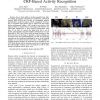846 search results - page 26 / 170 » Location-Based Activity Recognition |
HUC
2007
Springer
14 years 2 months ago
2007
Springer
We study activity recognition using 104 hours of annotated data collected from a person living in an instrumented home. The home contained over 900 sensor inputs, including wired r...
CVPR
2011
IEEE
13 years 15 days ago
2011
IEEE
Cameras are ubiquitous everywhere and hold the promise of significantly changing the way we live and interact with our environment. Human activity recognition is central to under...
CVPR
2003
IEEE
14 years 10 months ago
2003
IEEE
Video-based recognition and prediction of a temporally extended activity can benefit from a detailed description of high-level expectations about the activity. Stochastic grammars...
WOWMOM
2009
ACM
14 years 3 months ago
2009
ACM
Opportunistic sensing allows to efficiently collect information about the physical world and the persons behaving in it. This may mainstream human context and activity recognitio...
ICPR
2010
IEEE
14 years 2 months ago
2010
IEEE
Abstract—Due to their ability to model sequential data without making unnecessary independence assumptions, conditional random fields (CRFs) have become an increasingly popular ...


